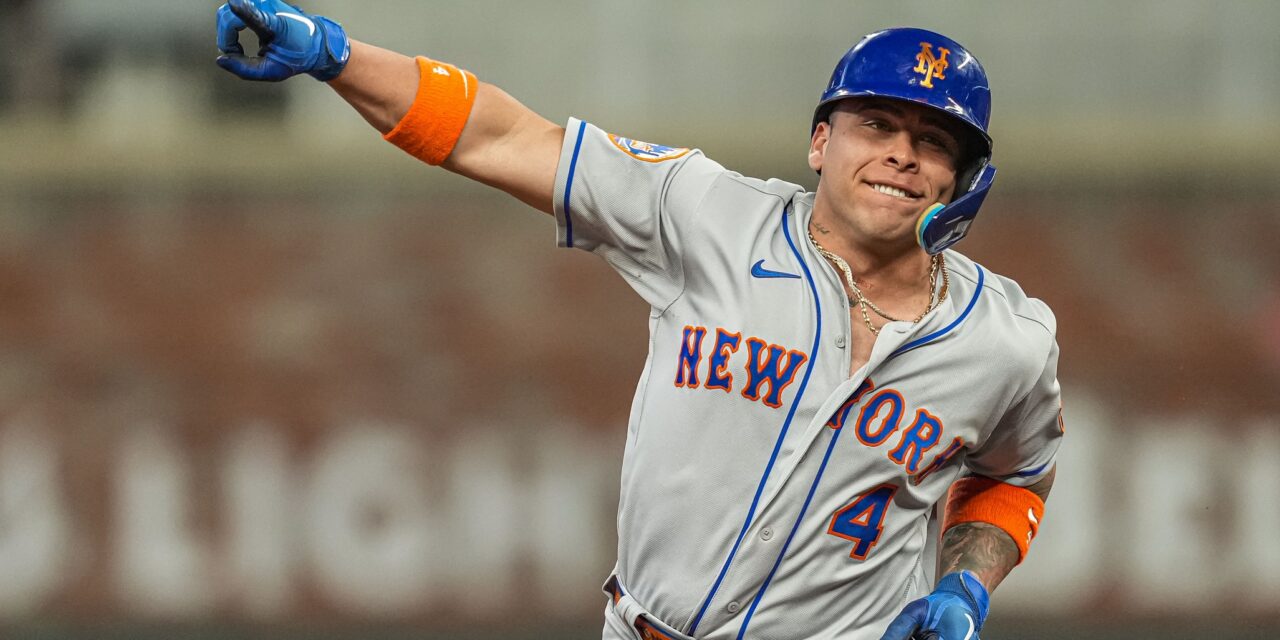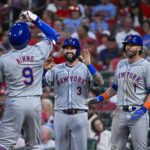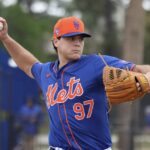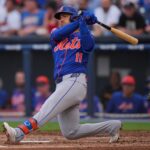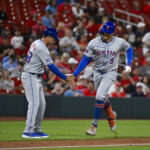At 42-48, the New York Mets’ 2023 season is on the rocks at the season’s artificial midway point. Pete Alonso was the team’s lone All-Star before injury replacements, and he was a commissioner selection to give the Mets one representative. That is emblematic of the across-the-board underachievement of this Mets team.
Finding three ups for the whole pre-All-Star break slate was even more of a challenge than doing so for any given series. Meanwhile, there were many downs to choose from. Therefore, it was easiest to go specific on the 3 Up and general on the 3 Down.
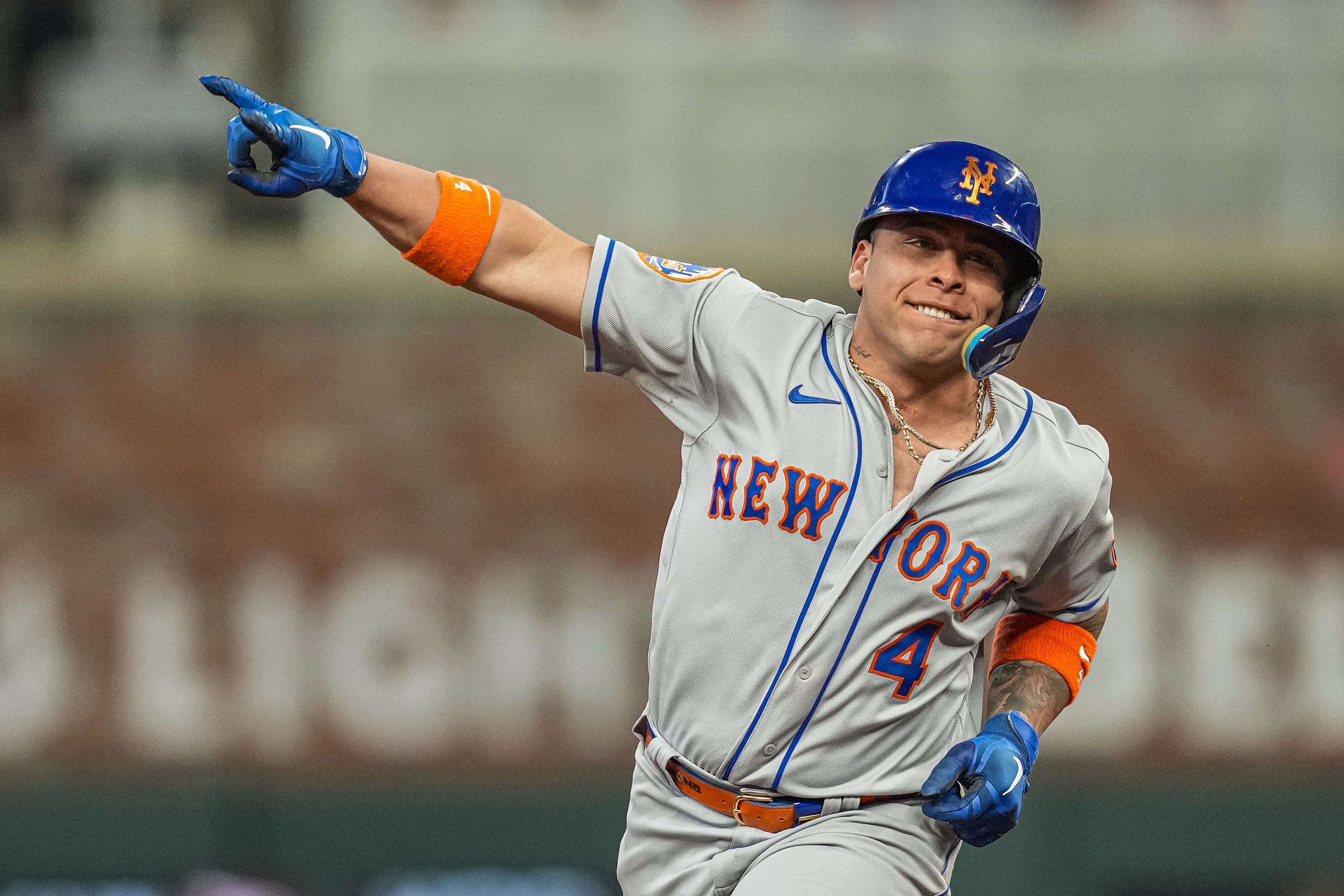
Dale Zanine-USA TODAY Sports
3 Up
Power Play
Francisco Álvarez is a pleasant surprise for the Mets overall this year. Many did not expect him to join the big-league club for most if not all of the season, but Omar Narváez‘s two-month calf injury gave Álvarez an opportunity. The rookie isn’t perfect, but he’s provided the power that most of the Mets’ lineup sorely lacks. His .238/.295/.514 slash line has its problems, but his .809 OPS is undeniably a boon for the struggling Mets offense.
Finding consistency, getting on base more often, striking out somewhat less, and reducing his groundball rate (46.7%) are still things for Álvarez to work on. Still, if the 21-year-old keeps this up, he will finish in the top few slots for the NL Rookie of the Year.
Furthermore, Álvarez continues to frame pitches well, as he is in the 74th percentile among catchers in that category. Álvarez has grabbed the Mets’ catching job by the horns and is not letting it go. It’s a silver lining on an otherwise miserable season.
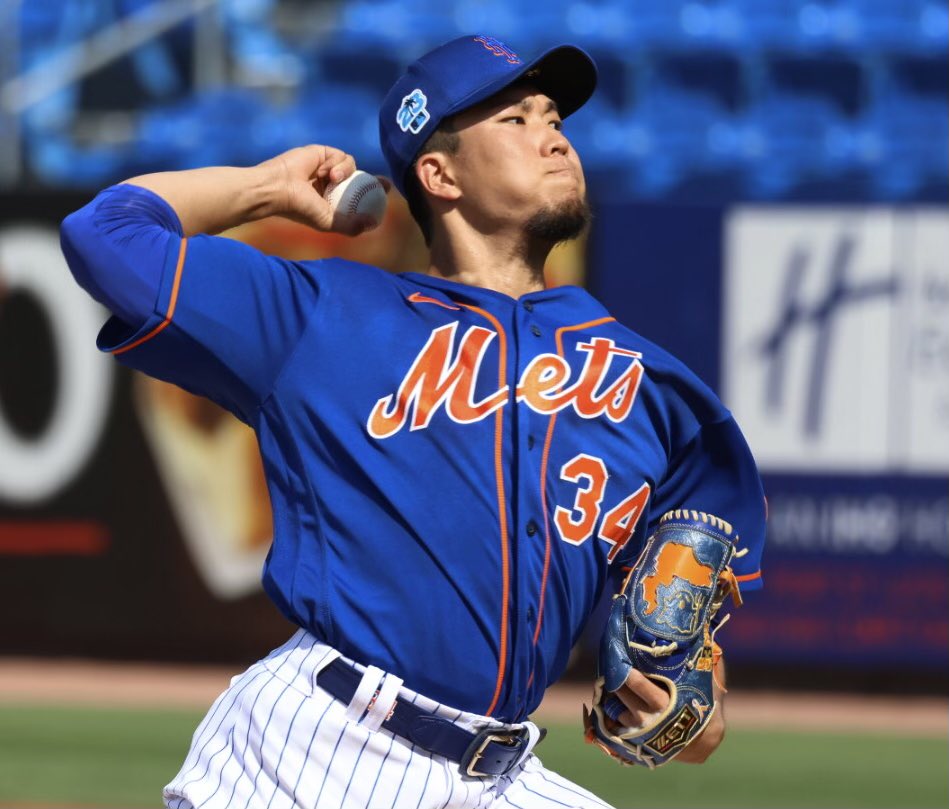
Kodai Senga. Photo by MMO’s Ed Delany
Senga Exceeds Expectations
Another rookie, albeit nearly a decade older, has also given the Mets a boost. Kodai Senga‘s strong starts have become more frequent as he acclimates to the American scene. As the Mets’ third starter, here’s how Senga’s numbers compare to Chris Bassitt‘s at the same point last season.
- Senga 2023: 89.2 IP, 3.31 ERA, 1.28 WHIP, 3.85 FIP, 3.77 xFIP, 11.34 K/9, 4.72 BB/9, 1.00 HR/9
- Bassitt 2022: 109.2 IP, 3.79 ERA, 1.14 WHIP, 3.83 FIP, 3.55 xFIP, 9.18 K/9, 2.47 BB/9, 1.24 HR/9
Obviously, Bassitt pitched many more innings because Senga has needed extra rest and hasn’t always been efficient. Still, Senga has done an admirable job for the Mets. His addition to the NL All-Star team as a replacement cemented his place as a strong performer on a team that has few of them.
Most of Senga’s Baseball Savant page is red because he is above average in most areas. His high walk rate (ninth percentile) and low chase rate (30th percentile) are the lone exceptions and are linked to each other. Finding more consistency with his pitches and playing them off each other is still a work in progress. When Senga is on point with his fastball and can throw it for strikes, he tends to pitch well as a whole.
Three Vets Do Their Jobs
There are three Mets veterans who have actually done their jobs this season: Tommy Pham, David Robertson, and Brooks Raley.
After a rough patch in May, Pham finished the first half with a .277/.350/.485 (.835 OPS) slash line. He has 130 wRC+ and 1.3 fWAR despite below-average defense (-2 OAA, -3.5 DRS). His 93.3 mph average exit velocity ranks in the 96th percentile among batters. If anything, Pham has faced some bad luck despite hitting the ball hard, as his xBA is in the 96th percentile among hitters at .301, and his .529 xSLG is in the 93rd percentile. Pham has been a revelation, and he’s earned everyday playing time.
Meanwhile, another free-agent addition has also done a solid job. Robertson came in to split late-inning duties with Adam Ottavino but became the closer once Edwin Díaz went down. While that has taxed both him and the rest of the Mets’ bullpen, Robertson had a strong first half overall. He has a 2.06 ERA (3.07 xERA), 3.59 FIP (3.48 xFIP), 51 ERA-, and 4.18 K/BB ratio. He has converted 13 of 16 save opportunities but has 36 overall appearances, many in high-leverage spots.
Robertson could be in danger of overwork, as he is one of the Mets’ only effective relievers. Still, Raley has provided as much of a bridge as he can. His spots are more limited because he’s the Mets’ only regular lefty. In 31 1/3 innings, he has a 2.30 ERA (3.58 xERA), 3.98 FIP (4.47 xFIP), and 17 holds. Raley’s Baseball Savant page is also populated with red despite a fastball velocity that sits in the fifth percentile among pitchers.
Raley still has reverse splits, as left-handed batters are hitting .267/.328/.433 (.761 OPS) against him, compared to .179/.313/.268 (.581 OPS) for right-handers. If the Mets stopped using him as a lefty specialist of sorts, perhaps he would be even more effective. Still, this was a useful trade for the Mets to find another solid reliever.
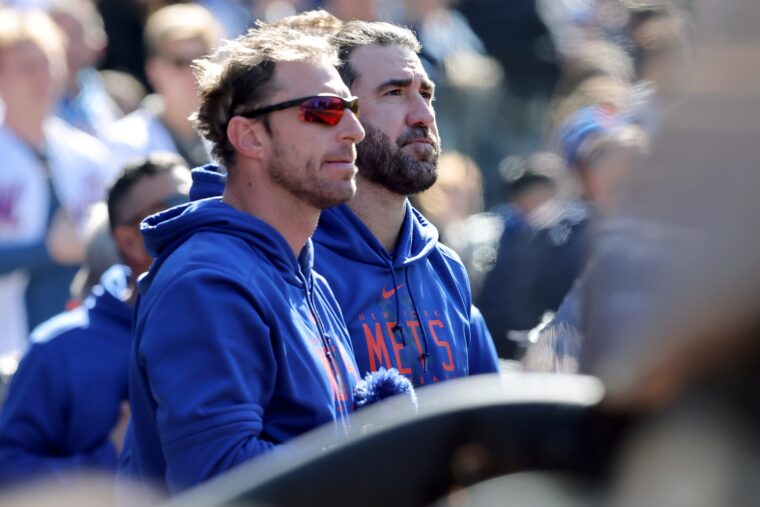
Brad Penner-USA TODAY Sports
3 Down
Aces Come Up Zeros
Max Scherzer did not pitch well over his last two starts of 2022 in key moments for the Mets. In 2023, those concerns have taken center stage as Scherzer yields home run after home run. Here is the difference between his numbers in the second half of 2022 (when he pitched more innings) vs. the first half of 2023:
- Post-All-Star Break 2022: 2.36 ERA, 0.930 WHIP, 2.84 FIP, .214/.259/.341 (.600 OPS), .264 wOBA, 9.8 K/9, 6.92 K/BB, 0.83 HR/9
- Pre-All-Star Break 2023: 4.31 ERA, 1.23 WHIP, 4.54 FIP, .252/.303/.450 (.753 OPS), .324 wOBA, 10.4 K/9, 4.39 K/BB, 1.85 HR/9
Unless Scherzer is somehow tradeable and willing to waive his no-trade clause, he will most likely be a Met not only for the duration of 2023 but also in 2024 when he has a $43.3 million player option. Expecting him to rebound is difficult at this point. When a 38-year-old ace declines sharply, a bounce-back is far less likely than the victory of Father Time. Scherzer has had some small stretches of nice starts, but consistency eludes him.
Meanwhile, Justin Verlander is a fellow overpaid ace appearing to be on the downside of his career. Verlander ping-pongs around between good and bad starts. It’s possible that he is pitching through an injury after spending time on the injured list with a teres major strain. Still, here are his numbers from the first half of 2023 compared to the first half of 2022.
- Pre-All-Star Break 2022: 1.89 ERA, 0.88 WHIP, 3.08 FIP, .194/.238/.298 (.536 OPS), .238 wOBA, 8.89 K/9, 5.68 K/BB, 0.91 HR/9
- Pre-All-Star Break 2023: 3.60 ERA, 1.20 WHIP, 3.99 FIP, .243/.293/.392 (.685 OPS), .298 wOBA, 7.33 K/9, 3.00 K/BB, 1.03 HR/9
Those numbers aren’t terrible, but they’re not what he’s being paid $43 million per year for.
Overall, the lack of ace pitching from the Mets’ co-aces could be the biggest reason that the season has gone off the rails. Yes, there have been many other problems, but a team looks to its best pitcher(s) to stop the bleeding. Instead, both pitchers have not done so.
The Rest of the Vets Don’t Do Theirs
Where to start? The majority of the Mets’ veteran hitters are severely underachieving. Jeff McNeil, Daniel Vogelbach, Starling Marte, Mark Canha, Francisco Lindor, and Alonso have all underperformed for large segments of 2023.
The fact that five hitters in the Mets’ starting lineup suddenly and dramatically declined is almost inexplicable. Lindor has come out of his shell over the past few weeks, so we’ll exclude him from this picture. But after a hot start, Alonso certainly belongs in this category.
Here is the point loss in OPS, wRC+, and batting average from 2022 to 2023 for each of those players.
- McNeil: -177 OPS, -52 wRC+, -73 BA
- Vogelbach: -103 OPS, -30 wRC+, -13 BA
- Marte: -170 OPS, -53 wRC+, -36 BA
- Canha: -22 OPS, -16 wRC+, -21 BA
- Alonso: -62 OPS, -20 wRC+, -60 BA
One particularly noticeable aspect for the Mets is a sharp decline in BABIP. Alonso’s career BABIP is .263, which is below the league average, but it’s an incredible .186 this season. McNeil’s is down from his career average of .325 and his 2022 figure of .353 to .282, which is nearly identical to his .280 mark from 2021. Lindor’s is down from .291 career to .254. Marte’s is the most explainable, as it’s down from .342 career to .309, and his loss of speed likely has something to do with it. Canha’s is down slightly from .289 career to .276, but he was at .309 last season.
Perhaps a team that is so reliant on BABIP has fallen prey to its whims.
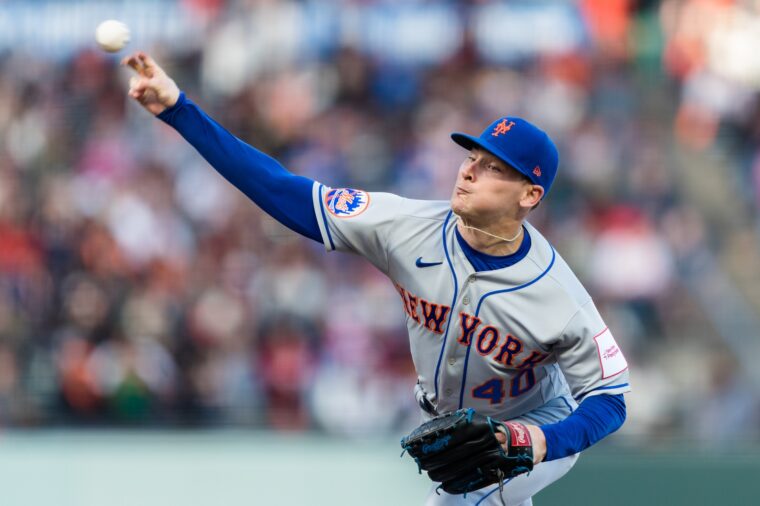
John Hefti-USA TODAY Sports
Middle Relief Disaster
One of my first articles on Metsmerized expressed the opinion that Billy Eppler was taking an erroneous approach to the bullpen. After a report by Andy Martino that the Mets were seeking optionable relievers, I argued that the Mets needed more proven veterans in the bullpen. This was before Díaz went down for the season.
Indeed, my worst fears have come to pass in this area. Eppler should shoulder most of the blame since he cannot even blame regression or underachievement for most of the team’s failures. True, he could not have foreseen Díaz’s injury, but the bullpen was lacking even without that.
Relying on Drew Smith to be one of the key relievers in the bullpen was foolhardy when the right-hander allowed 1.76 HR/9 in 2022 and 1.53 HR/9 in 2021. Sure enough, although Smith’s 1.22 HR/9 rate this season does not seem quite as bad on its surface, he’s been tagged for 1.83 HR/9 since May 1 after a solid start.
Much of Smith’s Baseball Savant page is blue, encompassing his average exit velocity (20th percentile), hard-hit rate (30th), xERA/xwOBA (30th), xSLG (35th), barrel rate (3rd), walk rate (20th), and chase rate (20th). Despite above-average fastball velocity and a strikeout rate in the 75th percentile, opponents have a .424 batting average and a .788 slugging percentage against Smith’s secondary pitches. Even his fastball has an xSLG of .408 and a 91.3 mph average exit velocity despite a .135 batting average against and a .230 SLG.
Meanwhile, Ottavino is in the down-year phase, which he seems to flip-flop yearly. After a masterful 2022, Ottavino has been unreliable in 2023. Here is Ottavino’s 2022 vs. 2023 comparison.
- Ottavino 2022: 65 2/3 innings, 2.06 ERA, 2.35 xERA, 2.85 FIP, 2.79 xFIP, 4.94 K/BB, 89.1% LOB%
- Ottavino 2023: 36 1/3 innings, 3.72 ERA, 3.45 xERA, 4.79 FIP, 4.37 xFIP, 2.24 K/BB, 80.5% LOB%
If the rest of the bullpen was even marginally reliable, perhaps Ottavino’s regression would be tolerable. However, the Mets rely on him in high-leverage spots, and he often has not delivered. Relief pitching is always a dicey prospect, and on this one, the Mets simply are not getting the same benefit they did a year ago.
After Smith, though, the next mistake the Mets made in the bullpen was keeping Stephen Nogosek as the long reliever. Although Nogosek posted a 2.45 ERA in 2022, his xERA was 3.89, and his FIP was 4.66 (4.51 xFIP). He also threw just 22 total innings in the majors. Using him as the long man to replace Trevor Williams simply because he was out of options was a very risky plan. Sure enough, Nogosek has a 5.61 ERA with a nearly-identical xERA and a 6.20 FIP (5.20 xFIP) in 25 2/3 innings.
This one was highly predictable. Nogosek has been a journeyman throughout his career, shuffling between Triple-A and the majors. It might have been wiser to try to use Tylor Megill or Joey Lucchesi in the long relief role rather than sticking with Nogosek.
Other JAGs whom the Mets have relied on for key innings out of the bullpen include John Curtiss coming off Tommy John surgery, Jeff Brigham, Denyi Reyes, Dominic Leone, Dennis Santana, Josh Walker, Tommy Hunter, Jimmy Yacabonis, T.J. McFarland, Grant Hartwig, and recent acquisition Trevor Gott.
Every team has some rotation of waiver-wire pickups and career minor leaguers who make appearances out of the bullpen. However, failing to replace Williams and Mychal Givens with reliable arms was a huge misstep, even assuming that Robertson replaced Seth Lugo and Raley came in for Joely Rodríguez.
The Mets open the second half of the season with a six-game homestand beginning Friday night against the Dodgers (7:10 p.m. ET). Verlander will take the mound against Julio Urías, who has had big struggles of his own for Los Angeles.


